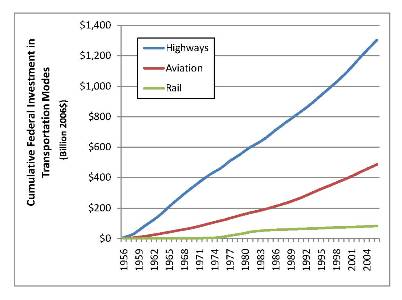
New Report: The Right Track
Efficient passenger rail service is a clear winner of an investment: it is more energy efficient, less damaging to the environment, eases our dependence on oil, and can help support more sustainable patterns of development.
A couple of weeks ago, the Obama administration announced the winners of $8 billion in high-speed rail funding under the American Recovery and Reinvestment Act. What quickly dawned upon the media, however, was that the $8 billion in the stimulus bill was just a small down-payment on the larger investment necessary to build a real high-speed rail system for America.
Our new report, The Right Track: Building a 21st Century High-Speed Rail System for America (written in conjunction with U.S. PIRG Education Fund), documents the benefits in store for regions across the country from increased investments in passenger rail. There is lots of detail in the report which I won’t recap here (whew!), but I did want to address head-on the biggest question about high-speed rail: the cost.
Let’s start off by acknowledging that high-speed rail – and particularly true high-speed rail, that is, bullet trains – is expensive. A new high-speed rail line of the type being built in California or Florida is a major capital project, costing billions of dollars and with all the potential for cost overruns and other problems as other “megaprojects.”
But if rail is expensive, so are all other high-capacity transportation systems. The choice America faces isn’t between building high-speed rail and doing nothing – rather, it’s between passenger rail, wider Interstates and bigger airports, all of which are very expensive. Here in my neck of the woods, for example, we just spent $14 billion to bury several miles of Interstate under downtown Boston.
Looking forward several decades, efficient passenger rail service is a clear winner of an investment: it is more energy efficient, less damaging to the environment, eases our dependence on oil, and can help support more sustainable patterns of development.
Part of the reason that high-speed rail appears challenging now is that we’ve invested so little in our rail network over the last half-century. In the post-war era, the federal government made key strategic investments in our air and highway networks. No such investments were made for rail, and federal support for rail still lags far behind that for highways and air travel.

Cumulative federal transportation spending, 1956-2006.
Now is the time to fix that imbalance and build a passenger rail network worthy of a major industrial nation. The Right Track shows that regions all across the country have much to gain, and little to lose, by making that investment.
Authors
Tony Dutzik
Associate Director and Senior Policy Analyst, Frontier Group
Tony Dutzik is associate director and senior policy analyst with Frontier Group. His research and ideas on climate, energy and transportation policy have helped shape public policy debates across the U.S., and have earned coverage in media outlets from the New York Times to National Public Radio. A former journalist, Tony lives and works in Boston.
